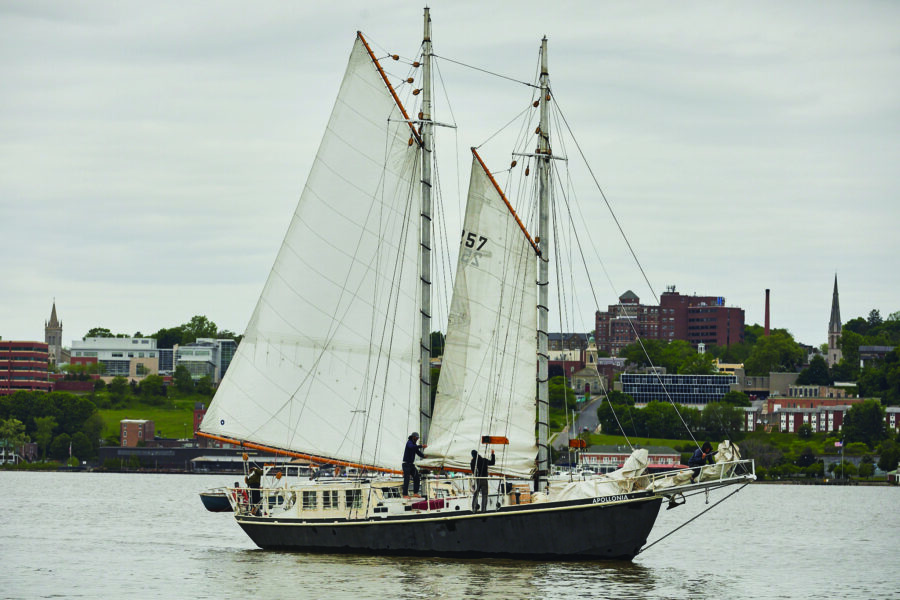Ap·ol·LO·ni·an /apəˈlōnēən/ adjective Relating to the rational, ordered, and self-disciplined aspects of human nature.
Sailing Out
The sailors are barefoot as they tread across the steel deck, preparing to motor past the bobbing boats docked at a Brooklyn Bridge Park marina. Turns out, motoring out is an active enterprise. With five busy sailors doing various things with hatches, lines, jibs, and other sails. Captain Sam Merrett seems to be everywhere at once, his feet thudding across the deck and along the gunwales, to drop down to the engine compartment through a hatch in the floor of the wheelhouse. He tinkers with the engine, at one point handing up a quart container of what looks suspiciously like harbor water. Popping out of the floor hatch to take the wheel from Lu Yoder at the stern of the schooner, Merrett shouts directives down the length of the deck. Finally, we get under way.
The engine sounds tubercular and its thrum makes the steel deck vibrate with a constant, nerve-jangling rattle. Happily, when we pass the slips, Merrett kills the engine and those vibrations cease. It’s a relief—the boat stills, and now the only sound is the luffing of sails. We start tacking, the Apollonia’s course no longer the straight line of a motorboat; instead, the boat weaves back and forth to catch the wind powering us on to Red Hook. We’re enroute to deliver malt from Hudson Valley Malt to Strong Rope Brewery. The boat (and us on it) take on a gentle, rocking sway.
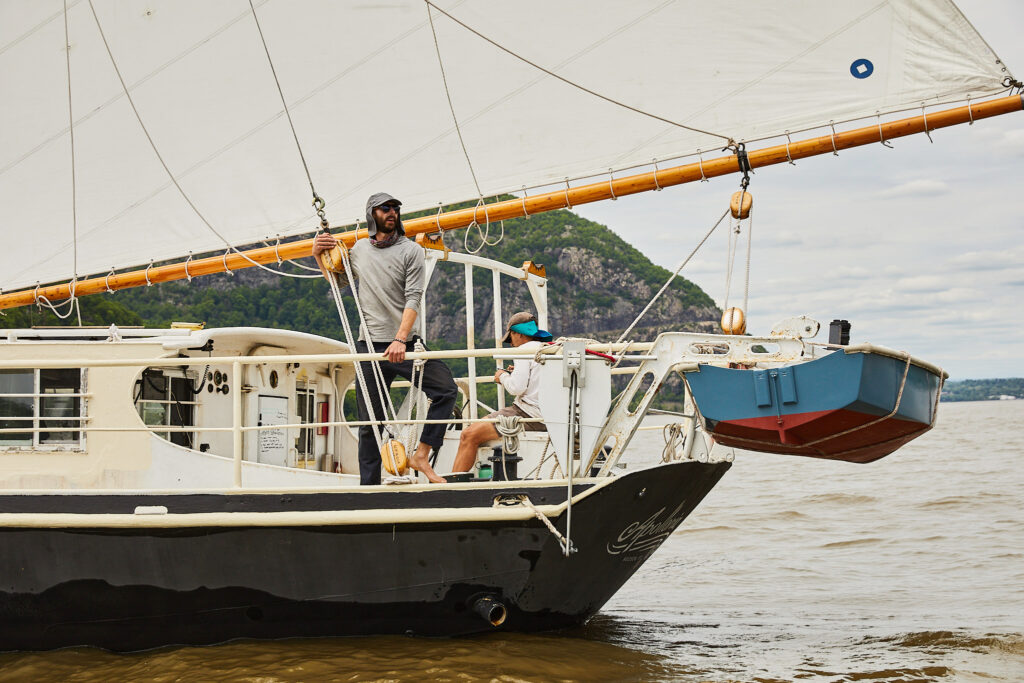
Who is the Apollonia?
The Apollonia is a modern cargo sailboat, a carbon-neutral alternative to the exhaust-belching trucks that haul produce and goods up and down the New York State Thruway. The schooner uses the Hudson River, our God-given transportation infrastructure, that—with its helpful tides, deep harbors, and access to the Hudson Valley’s natural resources and NYC’s industry—had historically been one of our nation’s most heavily used freight arteries. Much of the brick, lumber, and stone that built New York City was sailed down the Hudson. After the Erie Canal was completed in the 1830s (linking the Hudson to the Great Lakes), cargo that sailed from the Hudson River fueled westward expansion. Nevertheless, by the mid 20th century virtually all of the Hudson’s sail cargo was rerouted onto diesel trucks.
For all his barefoot saltiness, Sam Merrett does not come to the Apollonia from sailing. Instead, he was working in alternatives to fossil fuels. Having grown up in Rensselaer County, Merrett’s first business was in his Ohio college town; he converted diesel vehicles to operate on vegetable oil. In 2010, missing the Hudson Valley, Merrett moved his business to Hudson, NY, to the former L & B Furniture factory (now the Riverfront Antiques and Design Center). He says, “At the time, it had, like, the most ridiculously cheap rent. I rented 1,000 square feet in there for, like, $400 a month.” It was so big and so empty that he and his friends rode motorcycles through the building.
The riverside L & B Furniture factory had an additional charm. Says Merrett, “You know, when you live in Hudson, it’s, like, ‘Holy shit—there’s the water,’ right? I just got super excited about it.” It helped that some of his Hudson friends had boating experience. “I had always had this idea of starting a nonprofit to help people access the water,” says Merrett. “I just got involved because I thought it was fun. And, honestly, a lot of what we were doing was educational work with kids, and I’ve always liked working with kids. So, I helped start this thing called the Hudson Sloop Club. You should have seen some of the stuff we were doing! Just wacky boat stuff, like building a bicycle-powered catamaran. Or we’d go through recycling bins and steal as many bottles as we could to try to build a boat out of them.” Here, Merrett course-corrects. “It was really fun, but we were talking about buoyancy and talking about water safety and all that.”
In 2013, the club hosted a visit from the Vermont Sail Freight Project. Says Merrett, “That was, like, a little homemade plywood boat from Vermont that was sailing cargo and dry goods from Vermont all the way to New York City. He marvels, “I was, like, ‘Oh shit, here I am modifying cars and trucks to run off vegetable oil—which is no doubt better than diesel, right?’ But when you think about sustainable, renewable energy, it’s hard to be as clean as wind and solar.”
“And then I just started looking around for boats.”
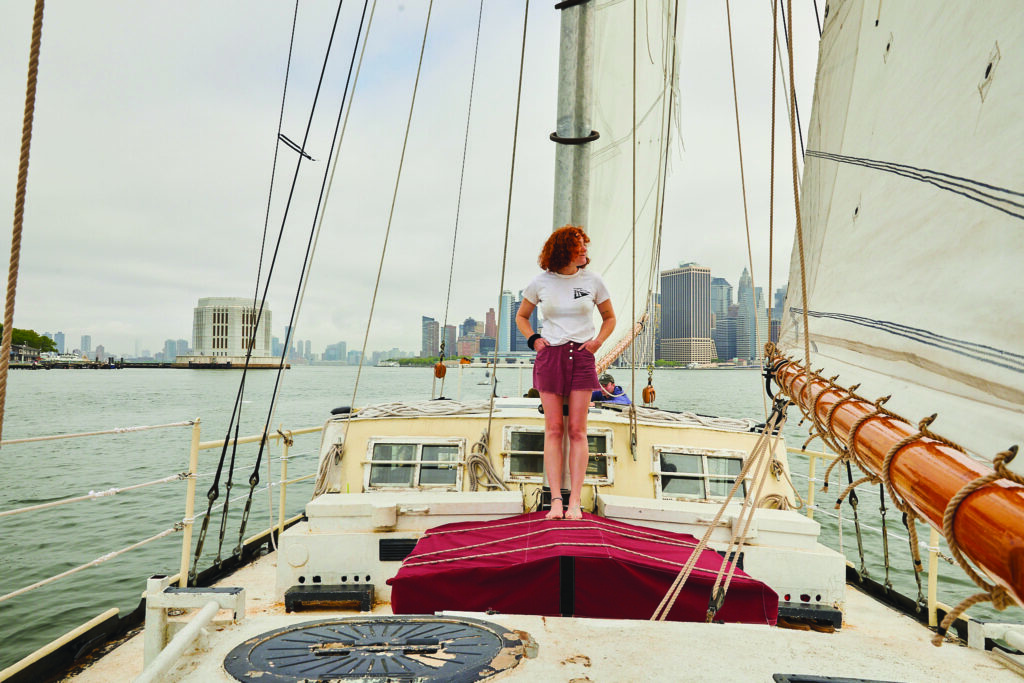
All About the Boat
In 2015, Merrett found a boat on Craigslist that suited his requirements: He figured he needed a 50- to 60-foot steel sailboat that could haul significant cargo while still being small enough to sail and dock easily. Built in the 1940s, the 64-foot Apollonia was in Woburn, MA, having lain derelict on a suburban property since 1983; its owner had subdivided his property and the Apollonia had to go. The boat was about to sold for salvage, but a potential buyer had commissioned Lu Yoder to compile a marine estimate for what it would take to restore the boat to haul cargo. That entity didn’t buy the Apollonia, but Lu’s appraisal ended up with Merrett. It was uncannily accurate, which Lu attributes to his lack of optimism. He snarks, “Only a jaded, battle-worn cynic comes up with an accurate estimate.”
At $15,000, the boat was dirt cheap. Says Merrett, “The price was so low because hidden in that purchase price was the headache of how the heck are you going to move it? It cost me more money to move the boat than it did to buy it, and I’m fairly resourceful.” He says, “I made these little flexible conduit risers so that when we drove through the neighborhood power lines, they eased them right over the top of the boat.” Still, no amount of McGuyvering was going to lessen the financial toll of hiring a professional boat mover and pulling permits to drive an over-height, overweight steel boat 70+ miles from Woburn to Marion, MA, where it could put in.
It took six years to get the Apollonia where it is today. Merrett wrote a business plan, set up an LLC as Schooner Apollonia, got some investors, and paid himself and some of his team with equity. He did a lot of labor himself. “I was fairly naive about what was ahead of me. And I think if I had known too much, I would have realized that this was crazy,” he laughs. “But I had the right balance of knowing enough to get stuff done, but not knowing enough to see what I was getting into.”
His varied struggles brought him into contact with a vast number of people from all areas of the boat world. Merrett also worked on other boats in trade for knowledge, favors, and advice. “In the end, it’s been valuable to have done it the way I did—because every step of having to ask for advice from someone, having to borrow a shop from someone, or having to find the specific person who knows one particular area, all put me in a unique place. I had accumulated this wonderful network of really smart people.”
The Apollonia 2.0 made its maiden sail in the fall of 2019.
RELATED: The Billion Oyster Project: Reversing History to Move Forward
Life Onboard
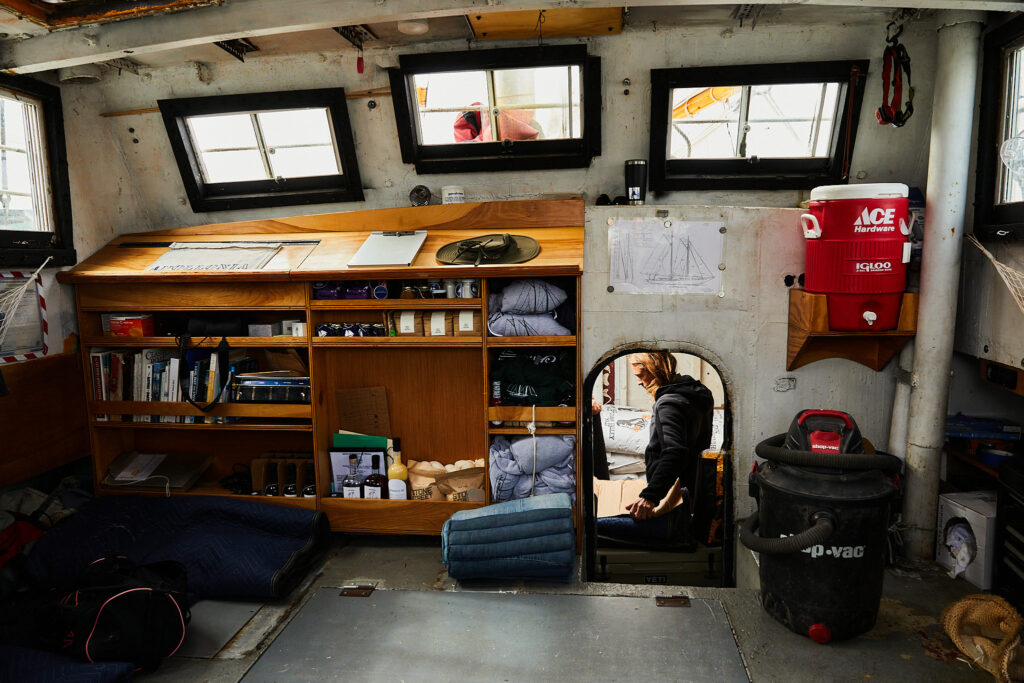
Schooners require fewer sailors to operate than other boats, but, at 64 feet the Apollonia still needs three, though Merrett prefers five. These folks live together on 12-day voyages with two additional days spent preparing the boat, provisioning, and loading in cargo. They work two weeks on, two off, from May through October excepting the month of July when winds are undependable. Belowdecks, there is a one-bunk room and a cabin in the fo’c’sle (at front of the boat) with two bunks. Merrett used to share this with sailor Matt Soltesz but the pair were incompatible. “When it’s bedtime,” Merrett says, “it’s time for me to do some emails and phone calls and catch up on stuff.”
Matt migrated to quieter pastures; Merrett is planning to turn the cabin into an office. “There’s actually another bunk in the crew quarters, which is really comfortable, that sometimes people sleep on. And then there’s this cool piece of furniture that was built in the galley. That’s gonna be like a lounge that will fold out to another bunk. So, we have three legitimate bunks, and then the whole wheelhouse.” In the wheelhouse, bunkless crewmembers kip in sleeping bags cushioned by quilted mover’s blankets. Merrett says that the only time the crew suffers sleeplessness is when they’re moored at docks where there are streetlights, noise, and mosquitos. When the boat is anchored in the river, they sleep like babies.
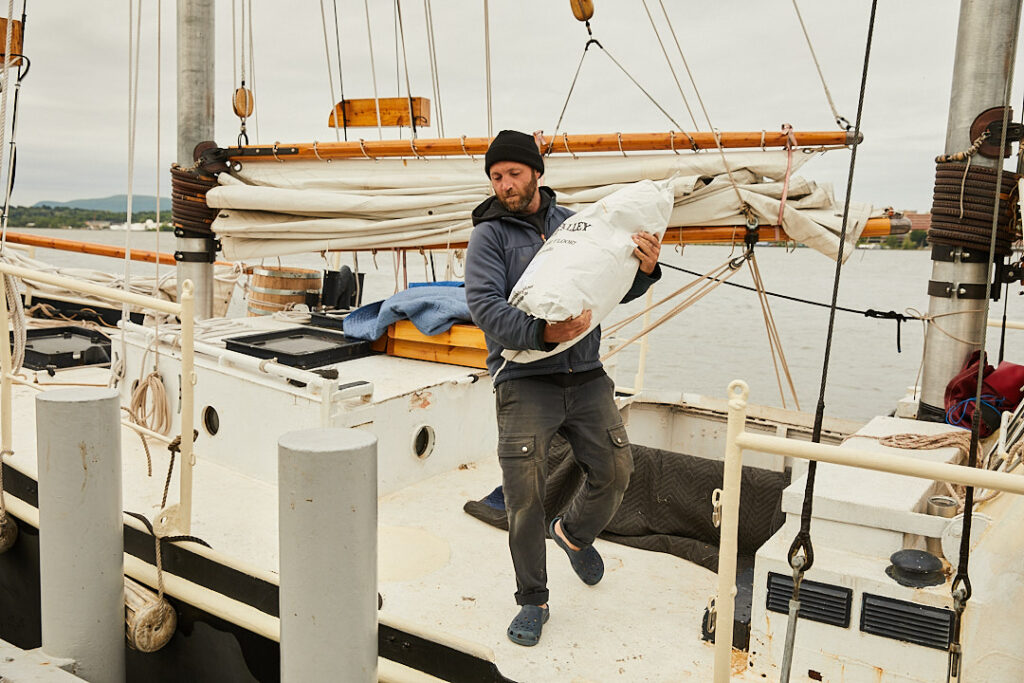
Crew Duties
Merrett is proud of the Apollonia’s composting head, which is actually a five-gallon bucket in which, after use, the contents are covered with cedar shavings from Matt’s second job as a woodworker. Merrett does the head’s dirty work himself. His reasoning for the composting head is part green and part just aesthetic. “A normal marine head just goes into a holding tank and it’s the grossest thing in the world. And then, when you get to a marina, you hook up this apparatus that sucks it all out.” He continues, “But I’ve been on a lot of boats where the marine head is disgusting. It’s an odor that is just on that boat. You smell it right away, and you know exactly what it is. It’s a bummer.”
The duties of cooking and provisioning are shared among the crew. Says Merrett, “I’m not opposed to having a cook, but I think it’s fun to have crew that does everything. Certainly, on our last trip, I’ll tell you, I think Lu, Matt, and I cooked all the meals—which is totally fine—it’s just not always an equitable distribution. But that just means other people do more dishes.” Merrett isn’t against the odd splurge. “We got Thai food when we were down in Red Hook and it was awesome, but other than that, we cooked every meal on the boat.”
The Apollonia’s solar panels power its icemaker and also a solar-assisted bicycle that, when on land, gets hitched to a small trailer. After manually lifting 50-pound sacks of malt out of the hold, the crew uses this rig to deliver cargo from the dock to its destination. They do this with remarkable cheer. Says Merrett, “I haven’t run out of coffee yet, which is probably be the only reason the crew would mutiny on me.”
Doing the Business
Hudson Sail Freight can’t compete with trucking on straight cargo transportation prices. A truck can make it from Hudson to Red Hook, Brooklyn, in a few hours, and maybe needs two drivers for deliveries. The Apollonia pays five sailors to achieve the same result, plus Merrett covers their room and board. But Merrett doesn’t want carbon-neutral shipping to raise prices, so the Apollonia delivers its goods for about what it would cost to ship by truck.
To solve the problem, Merrett and his crew—in particular, Brad Vogel, who handles onshore promotions, partnerships, and logistics—have become canny wheeler-dealers. They promote the generosity of some marinas on Apollonia’s website and social media in exchange for free docking. Other marinas offer space through goodwill. They sell retail “Boat Boxes” of curated goods that they buy from their shipping clients at wholesale, plus they hold events at breweries and on the boat when it’s docked.
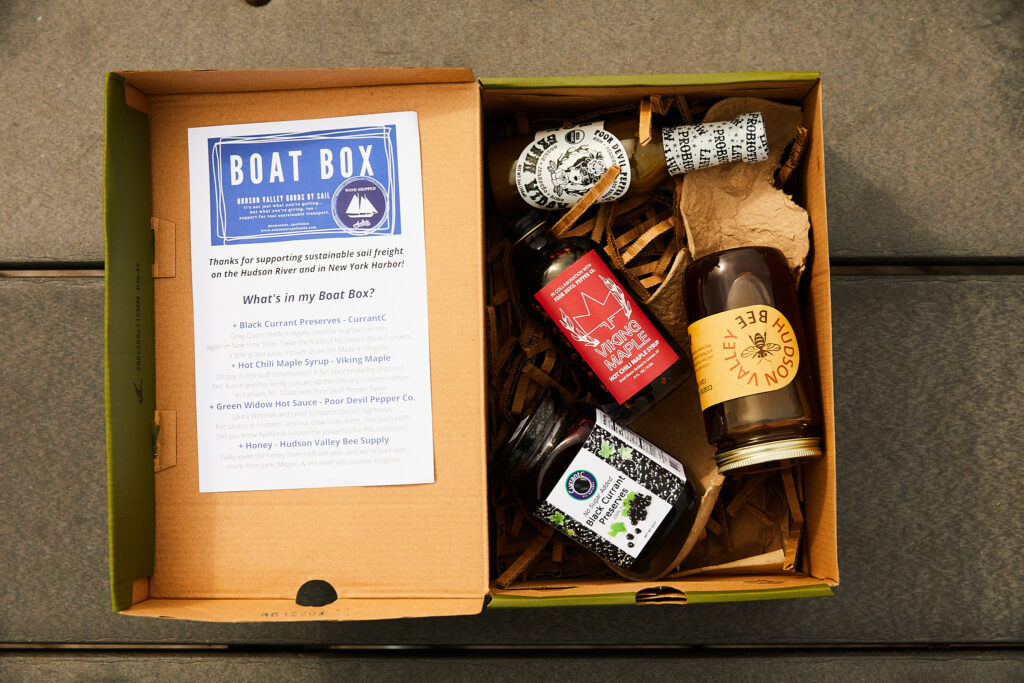
Finally, they’re getting into co-branding. Says Merrett, “We’re looking at new products that we can create. One of the best examples is with breweries. We can deliver more for what it would cost them to truck. But, then they can also release a special beer that costs another dollar per can for the people who are interested. And that dollar can be split between them and us, right? And so all of a sudden, we can have something where we create a new revenue stream that’s shared.” Currently, there is a barrel of North River Rye: Apollonia Edition whiskey aging on the boat. It’s a limited-edition product whose time on the Apollonia makes it more valuable. “It’s a great example of a product that we can help create—something that couldn’t exist without the boat.”
Nothing has been easy for Merrett and the Apollonia, and his revenue model has yet to be proven. “I’m not gonna lie to you, it does not work yet. But I think we’ll get there this year.” Merrett is hoping that in the way that the Vermont Sail Project inspired the Apollonia, his boat might inspire others. He’d like the Apollonia to be a part of a modern cargo fleet that silently and gracefully tacks on the Hudson.
To learn more about the Apollonia and the history of sail freight on the Hudson River, visit the Hudson River Maritime Museum in Kingston, NY. Or visit its website at hrmm.com. Also, follow the Apollonia’s travels via GPS at schoonerapollonia.com.
Feature image by Colin Clark


